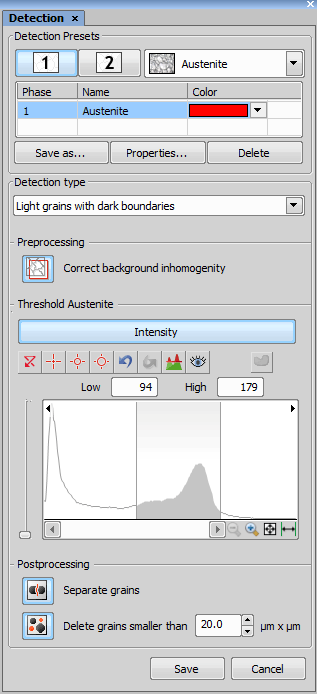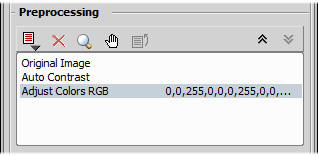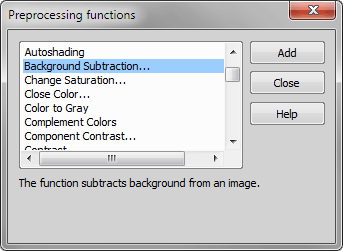 ,
, 
Selects number of detected phases. Select a particular preset from the nearby pull-down menu. This selection influences the set of available detection tools.
This button can save the current preset under a different name.
You can modify the name and the sample image of the current preset by selecting this button.
This button deletes the current preset.
The most frequent and typical detection types. The first is for bright field microscopy, the second is for dark field or polarized light microscopy. Both are based on the intensity threshold.
Designed for color etched, tinted or for samples analysed in polarized light (like e.g. aluminium); uses special image transformations and may be very sensitive to sample look.
A predefined procedure for detection of two phases. The user defines just the threshold value.
Enables an advanced user to define a custom sequence of preprocessing commands to prepare the image for detection. Other custom processing functions can be then applied to the binary image which resulted from the detection. See Advanced Detection.
Loads an external macro which would perform the whole detection procedure including threshold.
(requires: Local Option)
Uses the artificial intelligence Segment Objects.ai detection method (Segment Objects.ai) trained by NIS.ai . Only the “.oai” files present in the NIS-Elements installed GrainSize folder (e.g. C:\Program Files\NIS-Elements\nisai_networks\GrainSize) are shown in the Ai Detection list. Click on the arrow on the right to select the file. To load a file from a different location, use .
Adjusts the image in order to enhance the important image features (object borders, etc.) for easier thresholding.

This function corrects illumination inhomogeneities of the color image.
Specifying correct threshold limits is a crucial task of image analysis. The point is to determine, which pixels will and which will not be included in the binary layer, and thereby distinguish analyzed objects from the background. The Grain Size application uses the thresholding tool of NIS-Elements. There are only the following buttons added:
 Display Original Image
Display Original Image - changes are made to the image throughout the detection procedure. This button enables you to display the original image before any changes were applied.
 Auto Threshold
Auto Threshold - pressing this button modifies the threshold settings automatically according to what detection preset is selected.
See also Thresholding.
Adjusts the detected (segmented) objects to minimize false detections.

An automatic procedure which separates the grains connected accidentally by the thresholding procedure.

Detected objects smaller than the defined limit are excluded from the binary layer.
Whenever the settings are changed, these buttons becomes enabled. You can always use the button to store the changes to the current preset, or the button to discard them.
The preprocessing and postprocessing portions of the detection procedure may be customized. Select the Detection type > Advanced option. An editable table where single processing functions can be inserted appears within the Detection window.
The following tools are available:
 Preview
Preview Performs the so-far-defined procedure from the beginning to the selected function, and displays results.
 Original image
Original image Overrides all image changes and displays the original image.
Image Preprocessing
The first step of a successful detection is preprocessing. Prepare the image for the detection:
Press the
 Add function button. The list of available functions appears.
Add function button. The list of available functions appears.Select functions from the list one by one and press the Add button to include each one in the preprocessing. Or double click the function names. Close the list.
Within the selected functions, pick the ones you would like to change the parameters of. When a function has some editable parameters, the
 Edit function button becomes active. Press it to modify the parameters.
Edit function button becomes active. Press it to modify the parameters.Any function can be removed from the procedure by pressing the
 Remove function button.
Remove function button.Any function can be moved within the list by the arrow buttons in the top right corner of the window.
Object Detection - Threshold
Specifying correct threshold limits is a crucial task of image analysis. The point is to determine, which pixels will and which will not be included in the binary layer, and thereby to distinguish analyzed objects from the background.
Binary Layer Postprocessing
It is usually needed to process the detected binary objects using some morphology functions. Proceed in the same way as with preprocessing.
Note
Please refer to the electronic documentation for further information on the Binary Menu commands.
 Detection
Detection  View > Analysis Controls > Detection
View > Analysis Controls > Detection 

